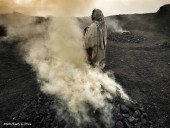Blacksmith Institute Press Release
The 2007 Top Ten of Worst Polluted Places
Updated List Includes New Sites in China, India and Central Asia
NEW YORK - September 12, 2007 - U.S.-based Blacksmith Institute, an independent environmental group, in partnership with Green Cross Switzerland, today issued their Top Ten list of the world's most severely polluted places. Overall, the Top Ten sites lie in seven countries and affect a total of more than 12 million people.
The Top Ten list appears in Blacksmith Institute's World's Worst Polluted Places 2007, a report on the places where pollution most severely impacts human health, especially the health of children. The 2007 list contains four new sites - two in India, one in China and one in the republic of Azerbaijan - and six that carry over from the list which debuted in 2006.
"The fact of the matter is that children are sick and dying in these polluted places, and it's not rocket science to fix them," says Richard Fuller, founder and director of Blacksmith Institute. "This year, there has been more focus on pollution in the media, but there has been little action in terms of new funding or programs. We all need to step up to the plate and get moving."
Killer Communities 2007
Blacksmith Institute's Worst Polluted Places list for 2007 lists the Top Ten alphabetically by country because within the list the sites are unranked. The report states, "ranking is not realistic or feasible...given the wide range of location sizes, populations and pollution dynamics." Sites new to the list are marked with an asterisk:
- Sumgayit, Azerbaijan*;
- Linfen, China;
- Tianying, China*;
- Sukinda, India*;
- Vapi, India*;
- La Oroya, Peru;
- Dzerzhinsk, Russia;
- Norilsk, Russia;
- Chernobyl, Ukraine; and
- Kabwe, Zambia.
"Worst" List Evolves
The Top Ten list is based on scoring criteria devised by an international group of experts including researchers from Johns Hopkins University, Hunter College, Harvard University, IIT Delhi, University of Idaho, Mt. Sinai Hospital, and leaders of major international environmental remediation companies who comprise Blacksmith Institute's Technical Advisory Board (TAB). Specialists from Green Cross Switzerland also participated in this year's assessment.
The methodology for 2007 Top Ten list was refined "to place more weight on the scale and toxicity of the pollution and on the numbers of people at risk," according to the report. The inclusion of Sumgayit and Vapi results from changes in the scoring methodology. Tianying and Sukinda were newly identified in this year's list development process.
"We received over 40 new site nominations from people around the world as a result of publishing the 2006 list. Our database now includes over 400 polluted sites," observes Hanrahan, Blacksmith's Director of Global Operations. "We will continue to refine the evaluation process and update the report yearly. Getting the problem of extreme pollution in the developing world on the 'radar' is a first step to taking action."
The Dirty Thirty
Another new feature of the 2007 report is the "Dirty 30," a more comprehensive group of polluted locations around the globe that includes the Top Ten. The four sites from the 2006 Top Ten that do not appear in the 2007 list - Haina, Dominican Republic; Ranipet, India; Mailuu-Suu, Kyrgyzstan; and Rudnaya Pristan, Russia - all remain in the larger list.
The majority of the Dirty 30 sites lie in Asia, with China, India, and Russia having the greatest number. The only geographic regions not represented in the Dirty 30 are the Middle East and Oceania. Toxic pollution in these sites has resulted from sources as diverse as massive industrial estates, large-scale mining and smelting operations and even Cold War era chemical weapons production.
"All the sites in the Dirty 30 are very toxic and dangerous to human health," says Hanrahan.
New Additions to the Top Ten
Mining, Cold War era legacy pollution and unregulated industrial production are the major culprits behind the pollution identified by the Blacksmith Institute report. Among the new sites to appear on the 2007 Top Ten list, Tianying, China, a massive lead production base, is responsible for half of the country's total output. Lead poisoning severely stagnates children's intellectual development.
Vapi, India exemplifies a region overwhelmed by industrial estates - more than fifty poison the local soils and groundwater with pesticides, PCBs, chromium, mercury, lead, and cadmium. Blacksmith Institute's report states, "Mercury in Vapi's groundwater 96 times higher than WHO health standards". Sukinda, India houses more than 97% of India's chromite ore deposits. Twelve mines operate without environmental controls, leaching hexavalent chromium into drinking water supplies.
Sumgayit, Azerbaijan is a former Soviet industrial base polluting the area with industrial chemicals and heavy metals. According to the report, cancer rates in Sumgayit are 22 to 51 percent higher than the national average; genetic mutations and birth defects are commonplace.
About Blacksmith Institute and Green Cross Switzerland
Blacksmith Institute works around the globe to identify dangerously polluted sites and initiate their clean up, using its Polluted Places methodology to focus efforts on the most productive interventions. For the biggest polluted areas, Blacksmith works with local partners, including environmental authorities, to identify large-scale interventions for potential funding by international agencies. Since 1999 Blacksmith Institute has completed 29 projects in 9 countries and is currently engaged in 42 projects in 12 countries.
Green Cross Switzerland works to overcome consequential damages caused by industrial and military disasters. The organization cleans up contaminated sites from the Cold War era with the major focus being on improving the lives of people affected by chemical and radioactive contamination. Green Cross promotes sustainable development in the spirit of co-operation in place of confrontation.
Blacksmith Institute and Green Cross have partnered since 2006. The two organizations are working together on a project to clean up pollution from legacy mining and smelting operations in Rudnaya Pristan, in Russia's Far East. The site was presented in the 2006 Top Ten listing.





